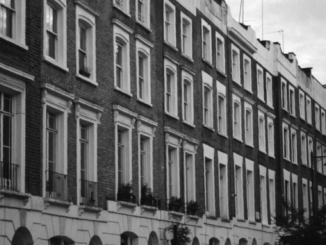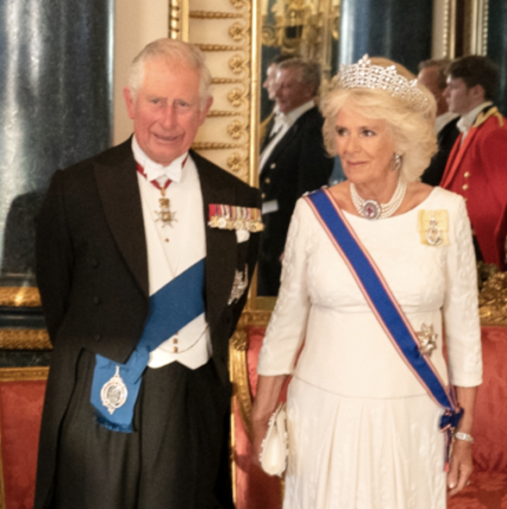
Charles and Camilla,
The White House – Public domain
Although that of King Charles III divides opinion, coronations remain fascinating events that have captivated the world for centuries. They are the ultimate display of power and prestige, as rulers are crowned and anointed in front of their subjects. These ceremonies are a grand occasion filled with pomp and pageantry, a time-honoured tradition passed down from generation to generation, a symbol of continuity and stability.
Today, coronations are held in fewer countries. Nevertheless, they remain a symbol of tradition and continue to captivate people’s imaginations. Whether you are a history buff or fascinated by the pomp and ceremony, the coronation is an event not to be missed.
Coronations in Westminster Abbey have been integral to our history for over a thousand years, since 1066 when William the Conqueror was crowned there. In the following ten centuries, every monarch of England, with the exception of two, has been crowned in the Abbey. The coronation ceremony is steeped in tradition and symbolism, with each element having a specific meaning and purpose.
The highly choreographed event involves a procession through the streets of London, culminating in the crowning of the monarch. The ceremony includes the anointing with holy chrism oil (which is done in private), the presentation of the crown, and an oath of allegiance.
After being destroyed in WWII, a new blend of holy chrism oil used for coronation had to be created for Queen Elizabeth II. Meanwhile, the Stone of Scone, an important artefact, was stolen from Westminster Abbey and recovered months later after being found on the altar of Arbroath Abbey.
For King Charles III’s coronation, new oil from olives pressed and perfumed with sesame, rose, jasmine, cinnamon, neroli, benzoin, amber and orange blossom needed to be consecrated in a ritual at the Church of the Holy Sepulchre in Jerusalem. The Patriarch of Jerusalem, His Beatitude Patriarch Theophilos III, and the Anglican Archbishop in Jerusalem, The Most Reverend Hosam Naoum, carried out the ritual of making the oil sacred.
As for the Stone of Scone, after being gifted to Scotland in 1996, it returned to England for this Saturday’s ceremony and is being guarded by volunteers – just in case.
Prior to 1066 coronations took place wherever convenient, including Oxford and Canterbury. As every Puffin knows, in 973AD King Edgar was crowned at Bath. The first of those post-1066 exceptions was Edward V (the Boy King), presumed murdered in the Tower of London before he could be crowned. The second is Edward VIII who abdicated 11 months after succeeding his father, George V, and before the date set for his enthronement.
In better times, Queen Elizabeth II’s coronation took place on June 2, 1953, following the death of her father King George VI. A ceremonial delayed by more than a year due to the unexpected nature of the King’s death. Princess Elizabeth’s father died on Feb 6th 1952 while she visited Kenya, making her the first sovereign to accede while abroad for over two centuries. Her unfortunate predecessor being Hanoverian George I, delayed at The Hague by contrary winds while Queen Anne lay on her death bed.

Fleet Street during 1953 Coronation,
Anthony Harrison – Licence CC BY-SA 2.0

Coronation of Queen Elizabeth II,
BiblioArchives/LibraryArchives – Licence CC BY-SA 2.0
The 1953 event attracted 8,000 distinguished guests, 27 million viewers on television and 11 million listeners on the radio. Queen Elizabeth played a role in designing her own gown, which included embroidered flowers representing the United Kingdom and symbols of Commonwealth countries. The regalia included the St. Edward’s Crown and the Imperial State Crown, as well as the Sovereign’s Sceptre with Cross, the Sovereign’s Orb, and the Coronation Spoon.
After the Abbey service, a parade carried the Queen back to Buckingham Palace via Whitehall, Pall Mall, Picadilly, East Carriage Drive, Oxford Street, Regent Street, Haymarket and along the Mall. Rulers of the British protectorates led the procession. These included Queen Sālote Tupou III of Tonga and were attended by marching troops and a carriage procession taking a full 45 minutes to pass any particular point on the route.
Sālote endeared herself to the crowds by keeping her carriage roof open despite the rain and waving to those at the roadside. Not a stick insect, in a lighthearted moment Noel Coward at his waspish best speculated the Queen of Tonga’s accompanying diminutive husband might be her lunch.
Also on 2nd June 1953, news reached England of Edmund Hilary and Tenzing Norgay conquering the summit of Mount Everest. Later in the year, the Queen presented the 14 members of the party with special edition coronation medals with the extra wording ‘Mount Everest Expedition’.
Seventy years later, the coronation of King Charles III takes place on May 6, 2023, at Westminster Abbey. A more modest affair in different times, Queen Consort Camilla’s crown will not feature the Koh-i-Noor diamond, a monster 105-carat stone ceded to Victoria by Maharajah Ranjeet Singh at the end of the Second Anglo-Sikh War.
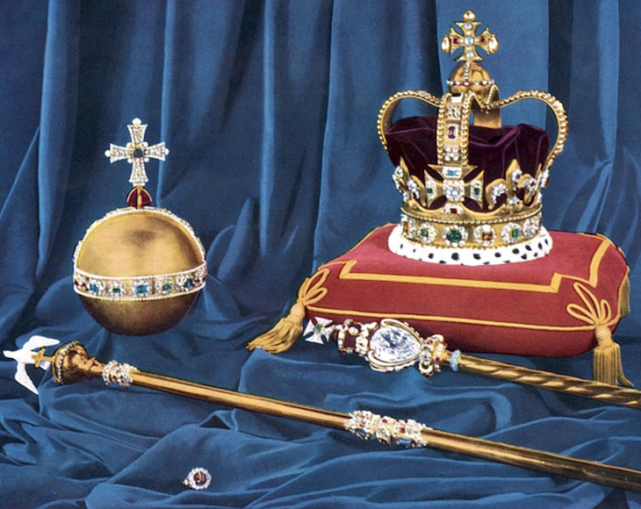
St Edward’s Crown, the Orb, the Sceptre with Cross, Sceptre with Dove, and the Ring,
UK Government – Public domain
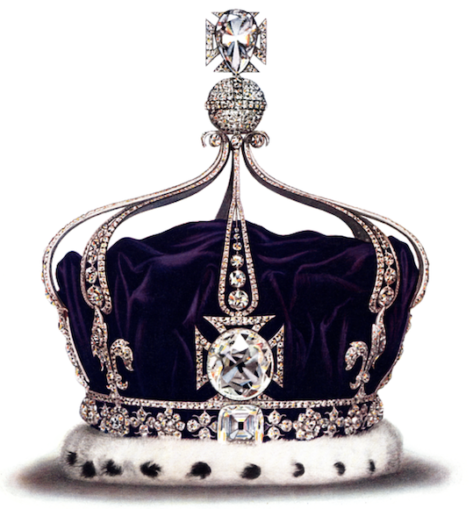
.
The Koh-i-Noor diamond in the front cross of Queen Mary’s Crown,
Cyril Davenport— – Public domain
His Majesty’s press have managed to find the Maharajah’s seventh-generation descendant, a Dr Jaswinder Singh Sukherchakia. Pictured on the sofa in his clay-daubed genealogy room in Amristar, Dr Sukherchakia appeared out of touch with the ironic anti-colonial wokeism of the new king as he told the Daily Mail,
‘If we wouldn’t have been offended by it then I don’t understand why anybody else would be. We wish Camilla and Charles all the best. I will be watching the coronation on television and was actually looking forward to seeing the Koh-i-Noor and feel quite insulted that it won’t be there.’
The military parade will also be diminished compared with seven decades ago. 29,000 service personnel from Britain and across the Commonwealth marched in the 1953 procession with a further 15,800 lining the route. Tellingly, those lining the route faced the monarch whereas for Kings Charles III tellingly they will be pointing the other way to scrutinise the crowds.
Colonel Burrows of the War Office staff led Elizabeth II’s parade, accompanied by four regimental bands. Then came the colonial contingents and troops from the Commonwealth realms followed by the Royal Air Force, the Army, the Royal Navy and, ahead of the royal carriage, the Household Brigade. After the end of the procession, the Royal Family appeared on the balcony of Buckingham Palace to enjoy a flypast. Bad weather on the day altered the flypast, but otherwise it took place as planned. 168 jet fighters flew overhead in three divisions thirty seconds apart, at an altitude of 1,500 feet.
The aircraft were 144 Gloster Meteors of the Royal Air Force and 24 Canadair Sabres of the Royal Canadian Air Force, commanded by Air Vice Marshal the Earl of Bandon.
The flypast preceded another on 15th June for the Coronation Review. The review being of the fleet and visiting navies at Spithead. The Fleet Air Arm did the honours.
Contemporary newspaper graphics showed countless vessels filling the Solent for the nine miles from East Cowes on the Isle of Wight to Southsea castle to the south of Portsmouth town centre. Above them passed 43 squadrons of aircraft. The jets circled the Isle of Wight clockwise and passed over Spithead from west to east. Those jets included Vampires, Meteors and Venoms.
Slower moving propellor aircraft took the long route over Bournemouth and Portland Bill. From there they headed inland as far as Salisbury before turning southeast to arrive at Spithead after following the River Test and Southampton Water. Led by Dragonflies of 705 Naval Air Squadron, the following squadrons consisted of, amongst others, Fireflies, Sea Fires, Sea Furies, Gannets and Wyverns. Remember – this was only the Fleet Air Arm, not our entire airborne fighting capability.
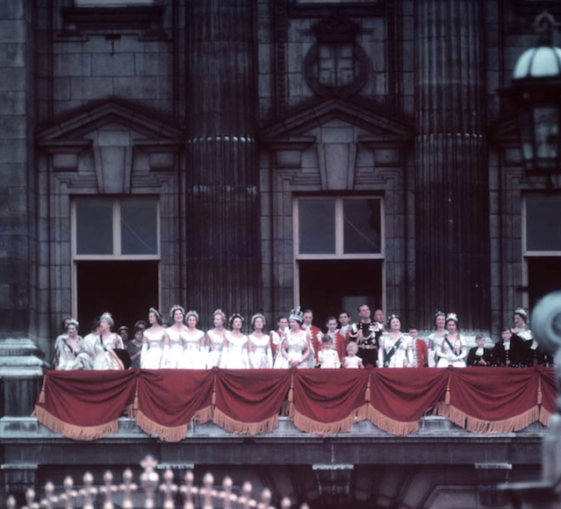
Coronation of Queen Elizabeth II,
BiblioArchives/LibraryArchives – Licence CC BY-SA 2.0

Peeling off… Australian pilots flying Meteor jets breaking formation,
Government of Australia – Public domain
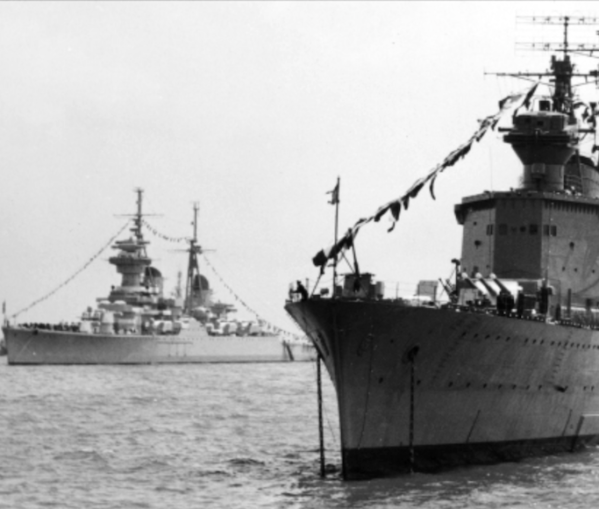
Warships from Sweden (right) and the Soviet Union (left) at the fleet review,
Unknown photographer – Public domain
On a happier note, 705 squadron survives to this day within 1 Flying Training School at RAF Shawbury.
In recent days six F-35s have been spotted rehearsing over RAF College in Cranwell. Forces.net informs us more than 6,000 service men and women from the UK Armed Forces will take part in the King’s parade supplemented by 400 Armed Forces personnel from at least 35 Commonwealth countries. A flypast will feature about 70 aircraft.
Although much diminished in numbers compared to those of our longest-serving monarch seven decades ago, what hasn’t changed is the professionalism of those men and women in uniform. No matter how the early days of our new head of state’s reign have been received, the services will do the nation proud, as they did during the ceremonials surrounding the Queen’s passing eight months ago.
© Always Worth Saying 2023


